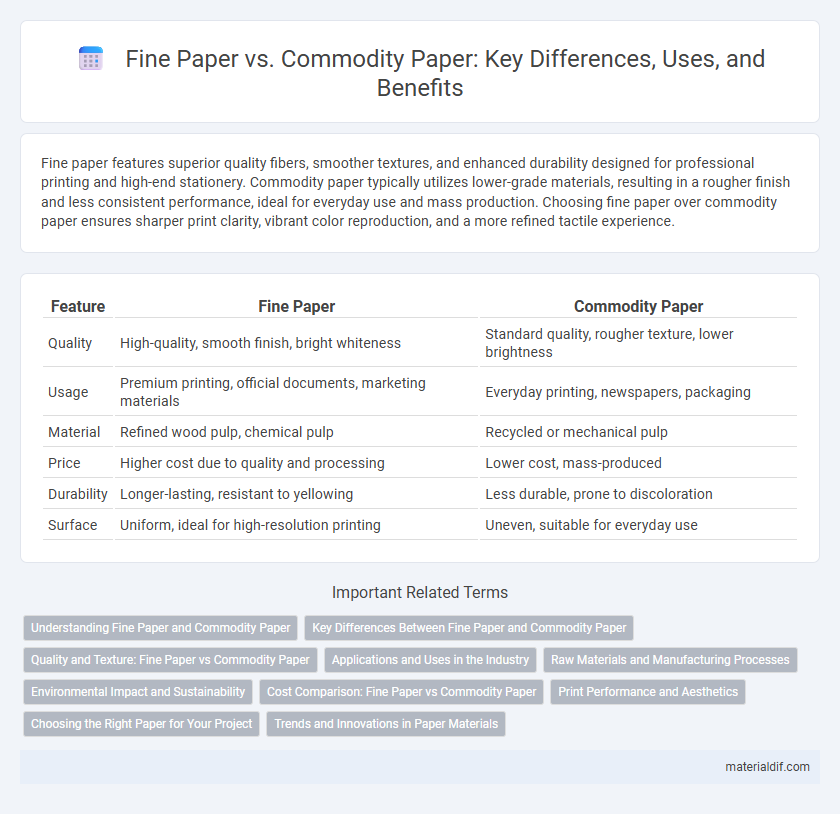Fine paper features superior quality fibers, smoother textures, and enhanced durability designed for professional printing and high-end stationery. Commodity paper typically utilizes lower-grade materials, resulting in a rougher finish and less consistent performance, ideal for everyday use and mass production. Choosing fine paper over commodity paper ensures sharper print clarity, vibrant color reproduction, and a more refined tactile experience.
Table of Comparison
| Feature | Fine Paper | Commodity Paper |
|---|---|---|
| Quality | High-quality, smooth finish, bright whiteness | Standard quality, rougher texture, lower brightness |
| Usage | Premium printing, official documents, marketing materials | Everyday printing, newspapers, packaging |
| Material | Refined wood pulp, chemical pulp | Recycled or mechanical pulp |
| Price | Higher cost due to quality and processing | Lower cost, mass-produced |
| Durability | Longer-lasting, resistant to yellowing | Less durable, prone to discoloration |
| Surface | Uniform, ideal for high-resolution printing | Uneven, suitable for everyday use |
Understanding Fine Paper and Commodity Paper
Fine paper is characterized by high-quality fibers, brightness levels, and smooth surfaces, making it ideal for printing premium documents and marketing materials. Commodity paper, often produced from recycled fibers, is more economical with lower brightness and durability, suited for everyday printing needs and mass-market applications. Distinguishing these papers by their fiber composition, manufacturing processes, and end-use performance helps in selecting the appropriate type for specific printing requirements.
Key Differences Between Fine Paper and Commodity Paper
Fine paper offers superior whiteness, smoothness, and opacity compared to commodity paper, making it ideal for high-quality printing and professional documents. Commodity paper typically has lower brightness and surface uniformity, resulting in more economical options suited for everyday printing tasks and mass production. The manufacturing processes for fine paper involve higher-grade pulp and stringent quality controls, while commodity paper uses more recycled fibers and simpler treatments to reduce costs.
Quality and Texture: Fine Paper vs Commodity Paper
Fine paper exhibits superior quality with a smooth, consistent texture that enhances print clarity and color vibrancy, making it ideal for high-end brochures and art prints. Commodity paper, typically produced with lower-grade fibers, has a rougher texture and less uniformity, which can result in diminished print detail and durability. The choice between fine and commodity paper significantly affects the tactile feel and visual impact of printed materials.
Applications and Uses in the Industry
Fine paper is primarily used in high-quality printing applications such as books, brochures, and premium stationery due to its smooth texture, brightness, and durability that enhance print clarity and color vibrancy. Commodity paper, often lower-cost and produced in bulk, is typically utilized for everyday printing needs like packaging, newspapers, and flyers where cost-efficiency outweighs premium finish. The industry relies on fine paper for products requiring superior aesthetic appeal and longevity, while commodity paper supports large-scale, budget-conscious production environments.
Raw Materials and Manufacturing Processes
Fine paper is typically made from high-quality virgin pulp derived from softwood fibers, ensuring strength, brightness, and smoothness, whereas commodity paper often utilizes recycled fibers or lower-grade wood pulp, affecting durability and texture. The manufacturing process for fine paper involves advanced refining, bleaching, and calendaring techniques to achieve superior whiteness and surface finish, contrasting with commodity paper's simpler processes aimed at cost efficiency. These differences in raw materials and production methods directly influence the paper's performance, appearance, and suitability for printing and writing applications.
Environmental Impact and Sustainability
Fine paper, typically produced from higher-quality fibers and often using recycled content, generally has a lower environmental impact than commodity paper due to reduced chemical usage and improved biodegradability. Commodity paper, mass-produced for everyday use, often relies on virgin wood fibers and heavier bleaching processes, increasing carbon emissions and deforestation risks. Sustainable choices favor fine paper with certifications such as FSC or PEFC, promoting responsible forestry and reduced ecological footprints.
Cost Comparison: Fine Paper vs Commodity Paper
Fine paper generally incurs higher production costs due to superior raw materials, enhanced processing techniques, and stricter quality control standards. Commodity paper, produced in large volumes with lower-grade fibers and minimal finishing, offers a more cost-effective solution for bulk printing and general use. The cost differential reflects the trade-off between premium aesthetics and functionality versus affordability and mass availability.
Print Performance and Aesthetics
Fine paper offers superior print performance with higher brightness, smoother texture, and better ink absorption, resulting in sharper images and vibrant colors compared to commodity paper. The enhanced surface uniformity of fine paper minimizes ink bleed and enhances detail, making it ideal for high-quality printing tasks such as marketing materials and professional documents. In contrast, commodity paper provides adequate print quality for everyday use but often lacks the refined finish and consistent aesthetic appeal crucial for premium print projects.
Choosing the Right Paper for Your Project
Fine paper offers superior brightness, smoothness, and durability ideal for high-quality printing projects like invitations and presentations, while commodity paper is more cost-effective and suitable for everyday printing needs. Choosing the right paper depends on factors such as print quality requirements, budget constraints, and the paper's weight and finish. Understanding these differences ensures the final product meets visual appeal and functional expectations for any project.
Trends and Innovations in Paper Materials
Fine paper continues to evolve with advanced coatings, sustainable fibers, and enhanced brightness to meet premium printing and packaging demands, differentiating it from commodity paper, which prioritizes cost-effectiveness and mass production. Innovations in nanocellulose and recycled fiber integration improve strength and printability in fine paper while maintaining eco-friendly attributes. Emerging trends include bio-based additives and digital compatibility enhancements, positioning fine paper as a high-performance material amid growing environmental regulations and digital shift pressures.
Fine paper vs Commodity paper Infographic

 materialdif.com
materialdif.com